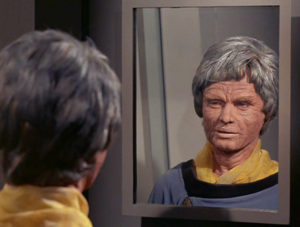Archive for the tos tag
Ari
August 24, 2016
Episode 44 – TOS 2×15: “The Trouble with Tribbles”
So as a heads-up, we don’t care what anyone thinks (up to and including Gene Roddenberry, who may or may not have despised it): this episode is comedy gold.
In this week’s among-the-most-famous and most universally-beloved episode, the Enterprise is summoned to space station K-7 by a Priority One distress call, but when it arrives, it turns out that the emergency in question was… xenophobia. There’s some strategically-super-important grain being stored on the station, and guess who’s hanging around near the station? Klingons. Apparently the bureaucrat in charge of protecting the wheat got jumpy and, well, jumped the gun, using a distress signal meant for imminent disaster.
Kirk, as you might imagined, is not impressed to discover that he hauled ass for… uh, wheat.
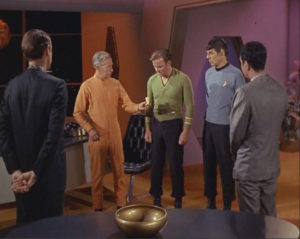
Also hanging around on the station is this guy:
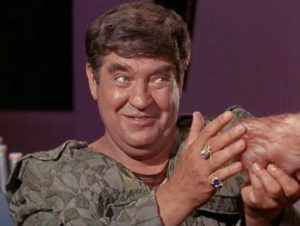
Cyrano Jones is a trader, and today he’s on Station K-7 trading, let’s face it, the cutest animals in the universe: tribbles. They’re soft, they induce feelings of calm and happiness, and even Spock admits that they make “a pleasing sound.” They’re basically guaranteed to take off as the Most Popular Pet for space-faring humanoids – at least, Uhura thinks so, because she acquires one (As a gift, for marketing, because she’s a communicator. Get it? GET IT?) and takes it back to the ship with her.
Where – as you probably guessed – something goes horribly wrong.
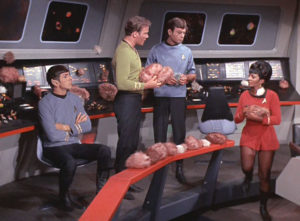
The tribbles start breeding out of control and eating everything. By the time the crew realizes that the tribble infestation might have started on the station, it’s too late: the tribbles have gotten into the super-important Space Grain (Quadrotriticale, officially, which comes from Future Canada, heyyyy!). This is bad for… strategy, but gold for comedy, because it gives us this scene:
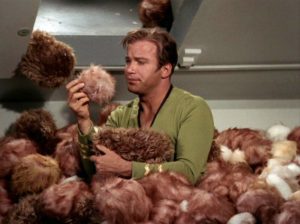
Honestly, does the rest of it even matter?
Podcast: Play in new window | Download | Embed
Subscribe: Apple Podcasts | Email | RSS
Ari
August 17, 2016
Episode 43 – TOS 2×14: “Wolf in the Fold”
So this episode is nominally a murder mystery, which honestly, made us give it a whole lot of bonus points right at the outset. Our crew is visiting Argelius, a port world where, well, to give you an idea, the law of the land is literally love. A couple of hundred years ago Argelians decided that work was stupid, fighting was boring, and conflict was the worst, and decided to devote their lives to seeking happiness and pleasure. Honestly, this sounds like a pretty sensible set of ideals on which to base a culture. The shocking thing is how generally gross the representatives of the Enterprise are acting in the first five minutes, sprawled out on cushions around a table leering dramatically at the nice lady dancer who is just trying to do her job, guys.
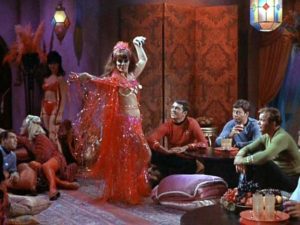
There’s arguably a plot reason for this, but it’s a stupid one: to manufacture a totally unnecessary motive for Scotty to be cast immediately as the suspect when the unfortunate young lady (Tara) is murdered about ten minutes later: Scotty recently suffered a concussion, which apparently, by insane 1960s space logic, has given him a “total resentment of all women” (yes, what the actual fuck is an excellent question to have here, though it did cross our minds that, if we’d believed it was deliberate, this is in some ways an incredibly modern way of viewing the relationship between brain injury and culpability in violent crime… though we pretty much came down on refusing to award credit on the basis of how stupid it sounds). Fortunately, Ship Pimp James Kirk is here to set him up with Tara, hoping they can bone that nonsensical resentment right out of him.
It’s almost funny how many more times Scotty ends up awkwardly positioned with blood on his hands over yet another murdered woman (three in total, RIP Tara, Lieutenant Karen Tracy, and Sybo), or it would be if this episode didn’t centre on a murderer whose motive is that it simply hates women.
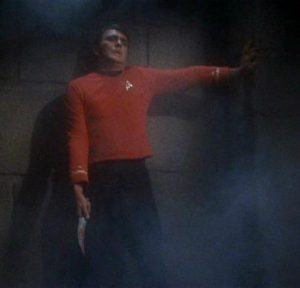
Yes, seriously, this is the explicit motive, for real.
By the virtue of Space Google, they discover that the culprit is, in fact, a deathless, millennia-old misogyny cloud possessing a series of man-shaped shells which was probably the truth behind the legend of Jack the Ripper, but still: this is so bananas that if a woman had written this episode, I would be tempted to think it was trying to be subversive.

As it is, we just have to sit back and admire the skillful use of Agatha Christie red flags in pointing loudly at the murderer in the first ten minutes of the story: out-of-towner, loner, obstructionist, and portrayed jarringly by John Fiedler, voice of Piglet.
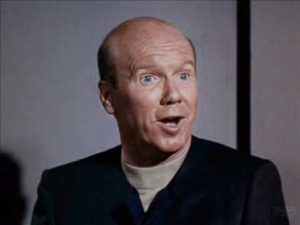
Yeah. Let that one settle.
Podcast: Play in new window | Download | Embed
Subscribe: Apple Podcasts | Email | RSS
Ari
August 10, 2016
Episode 42 – TOS 2×13: “Obsession”
This week we reach the midway point in season 2 of TOS (and arguably the halfway point in the series), potentially subtitled “Old Man Kirk Yells at Cloud” (there was some debate about this, given he never actually yells at the cloud).
It’s also probably the first installment in Trek’s long-running love affair with the Moby Dick metaphor. We can’t decide whether this is because of the hubris or the arrogance or just the inescapable naval associations, but Trek does love its sketchy vendettas against impossible monstrous foes. This time, it’s James T. Kirk vs. The Vampiric Sparklecloud Monster, which at some point in his early Starfleet career killed 200 people on board the U.S.S. Farragut, including his mentor, Captain Garrovick. When now-Captain Kirk recognizes the Sparklecloud’s funky smell during an away mission, he embarks on a renewed crazy vendetta which we felt would have been dealt with a lot more efficiently if he’d seen fit to, you know, explain himself to his crew rather than just, like, yelling at everyone.
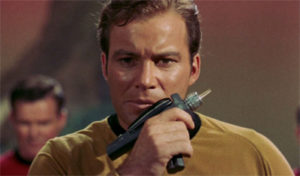
Probably the most frustrating thing about this story is that for most of it, the narrative seems committed to questioning Kirk’s motives in pursuing the Sparklecloud to the exclusion of all the Enterprise‘s other duties (aka: delivering perishable, time-sensitive vaccines to a Federation colony???): Kirk blames himself for the deaths on the Farragut (though no one else does; the record holds him blameless) and is being dangerously irresponsible in the interest of expiating that guilt. There’s even the added bonus that the son of his former captain is now on board the Enterprise as a security officer/constant reminder of Jim Kirk’s failures. Kirk’s yelling at his subordinates, being evasive, passive-aggressive and confrontational and basically behaving like a jackass. But then, a majority of the way through the episode, the narrative decides to change its mind, pulling a 180-degree turn to show that Kirk was, as it turns out, right all along.
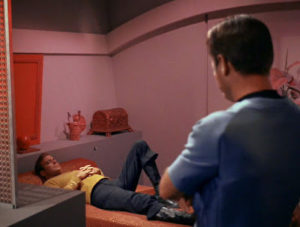
Since this episode falls at what was probably the height of the Shatner Interference Era of TOS, where said actor was engaged in a campaign of note-writing terror to make sure that his character was persistently portrayed as heroic and flawless, we’re willing to put this episode in the rearview and never think about it again. One day, this franchise will learn about Institutional Memory and Character development. We know, because we’ve seen it.
Podcast: Play in new window | Download | Embed
Subscribe: Apple Podcasts | Email | RSS
Ari
July 27, 2016
Episode 41 – TOS 2×12: “The Deadly Years”
This week, our crew comes upon a far-flung pseudo-colony where the members of a scientific expedition have come down with an acute case of The Olds.
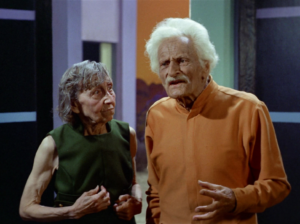
Naturally, they quickly discover that they’ve been infected with whatever is killing the expedition members. The medical staff springs into action, trying to cure the away team, but not before most of them (Chekov is mysteriously unaffected) start to descend into old age at an incredible rate… and not before the episode starts to devolve into the James Kirk Is Still Sexy Show. We blame the writing (and maybe Shatner’s ego), but just about everything from the moment he starts to go grey is focused on proving (and disproving) that Kirk is still attractive and virile.
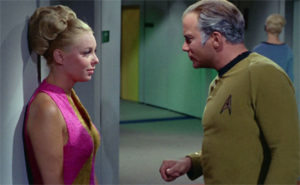
Yeah… we didn’t really care for this one, and I’m not sure what else there is to say about the episode, apart from “I want those 50 minutes of my brief and precious life back.” Kind of like Old!Kirk, I bet.
I definitely want back the 10 minutes 2/3 of the way through the episode where we pull into a narrative truck-stop to hold a competency hearing to re-tell the events of the episode so far.
There are an unprecedented number of lady background-characters in this episode, a great female guest star (Laura Wood) who did the best she could possibly have done with what she was given, and we do, at least, get one secondary lady quasi-redshirt, which is a step in the right direction? I guess?
450% older than most women are allowed to get in modern Hollywood
…sort of?
Podcast: Play in new window | Download | Embed
Subscribe: Apple Podcasts | Email | RSS
Ari
July 20, 2016
Episode 40 – TOS 2×11: “Friday’s Child”
This week, the Enterprise visits Capella, land of shiny rocks, where people stab each other for fun and call it a favour, and women literally belong to their male relatives. Sounds like a super-sweet potential trading partner, right?
Capella, a pre-warp civilization (Prime Directive? What Prime Directive?) whose aesthetic falls somewhere between “Vikings! Rarrr!” and what looks 1960s’ Hollywood’s idea of Mongolia, happens to mine some Very Important Minerals that are crucial to artificial life-support systems. Bones has visited Capella so far, on a sort of semester-abroad deal where he tried to convince the highly-Darwinist Capellans that medicine is a swell idea, and in a supreme waste of effort, does run them through the Capellans’ veritable minefield of murder-worthy taboos before they beam down… so naturally everything goes to hell within about fifteen seconds.
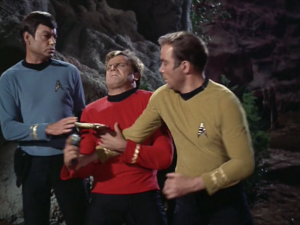
The other part of the episode involves a Capellan civil war precipitated by a Klingon interloper, and a flight through the hills with the very pregnant widow of the usurped Capellan Teer (portrayed by a very committed Julie Newmar), who must now, by the laws of her people, be put to death; something that well-meaning but clueless landing party obviously will not allow.
Somewhere in this episode, deep, deep down, there’s a really clumsy and uncomfortable conversation about cultural relativism and the how everything sucks for women everywhere, always, but most of it is lost in the progression of frankly insulting comments about how said lady – whose name is Eleen, pronounced Ell-ee-enn – has no idea what she’s talking about and doesn’t know what she wants in regards to subjects ranging from her survival to her culture to her pregnancy to her own bodily autonomy.
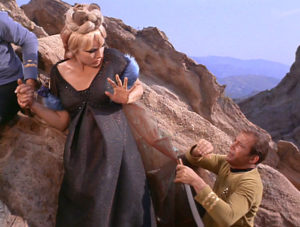
I mean, it turns around a little – mainly due to Eleen’s intervention on her own behalf once she puts that pesky childbirth business in the rearview. There follow some exciting and hilarious explosions and a series of frankly very silly grappling fights to defeat the Wicked Klingon and end the civil war. Eleen reclaims her life and her child and establishes herself as his regent – essentially the leader of the entire planet, after fifty minutes of being owned, dismissed, threatened, and smacked around by just about every man in the episode, including her doctor, while he is in the process of delivering her child. (And this in a D.C. Fontana episode! We can only assume the intervention of dudes later on in the process.)
It is… jarring, to say the least. Oh, Star Trek. As ever, you give me whiplash.
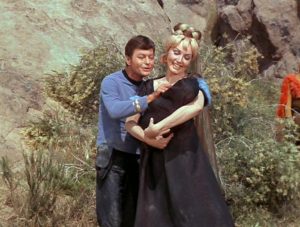
We can only hope that Eleen, Regent of Capella, teaches her son to know better.
Podcast: Play in new window | Download | Embed
Subscribe: Apple Podcasts | Email | RSS
Ari
July 13, 2016
Episode 39 – TOS 2×10: “Journey to Babel”
So this is probably my favourite episode so far, mostly because it’s FULL OF SPACE DIPLOMACY.
It’s also the first appearance of several Grand Trek Traditions, like Complaining about Dress Uniforms, and contains this scene, where Spock shows Bones how to do the Vulcan salute:
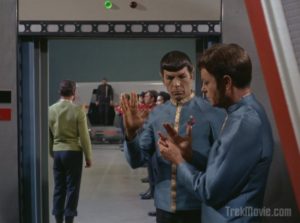
The Enterprise is ferrying a ship full of ambassadors to a summit on Codename Babel, where an important vote will take place: the admission of Dilithium-rich Coridan into the Federation. This is already a tense enough road trip – rife with sniping ambassadors and suspicions and accusations and ulterior motives – before the Enterprise swings by Vulcan to pick up their ambassador, Sarek, and his wife, Amanda… who happen to be Spock’s semi-estranged parents. That is: he’s kind of estranged from his dad but his mother mostly wants to know why he doesn’t visit more often. For Spock’s friends on the crew, this is literally the best thing that’s ever happened in space.
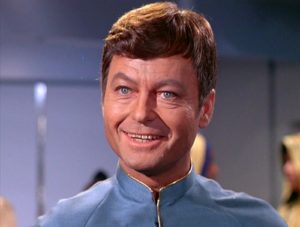
The episode from this moment on is split more or less evenly into two parts: the Vulcan family drama surrounding Spock and his father working out some of their differences, and the murder mystery that ensues when the Tellarite ambassador (who Sarek stops just short of flat-out accusing of being involved in illegal mining on Coridan) turns up dead, and Sarek is the main suspect. No prizes for guessing which part we enjoyed more.
Of course, this is a D.C. Fontana episode, so we’re already predisposed to love it. Tons of Vulcan-general and Spock-specific backstory, heaps of family-of-choice moments when Spock’s friends step in to stop him from doing something stupid he’ll regret forever, and several genuinely funny moments between Amanda and Kirk, who can’t believe he’s met another human being capable of out-sassing him and is obviously loving it.
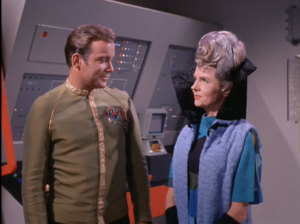
The heaping helping of Space Diplomacy, the window into the state of political affairs in the Federation, and a scene that seems to have been devised just to give Trek’s costume designers an excuse to showcase half a dozen new alien species, are just the cherry on top.
Podcast: Play in new window | Download | Embed
Subscribe: Apple Podcasts | Email | RSS
Ari
July 6, 2016
Episode 38 – TOS 2×09: “Metamorphosis”
Ah, Original Series: bastion of mystifying false dichotomies. Where you get Conspicuous Progressivism, you also get Astonishing Obliviousness Towards the Status Quo. For instance, this week’s episode contains both a scene where the Starfleet contingent of the cast are utterly nonplussed by the guest-star’s thinly-veiled-gay-panic-analog AND the message, shouted repeatedly through a narrative megaphone, that a woman’s life is meaningless without the love of a man.
That’s right, ladies: you’ve been wasting your lives.
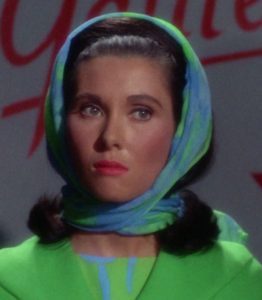
We open on a shuttle containing far too many members of the senior staff and one guest-star in the person of a Federation diplomat; she’s had to leave her Incredibly Important Negotiations to be rushed back to the Enterprise to receive medical treatment. But on the way, the shuttle Galileo (yes, that Galileo) is set upon by a malicious Glow Cloud and forced to land on Yet Another Shitty Planet, where they discover a man who claims to be Zefram Cochrane, who, uh, has officially been dead for over 150 years.
Now, if you’re passingly familiar with Trek canon, you might know that Zefram Cochrane is the dude who invented warp drive on Earth, a discovery that led directly to Earth’s First Contact with Vulcan and eventually, the formation of the United Federation of Planets. Kind of a big deal. Though the last time anybody saw him, he looked less like the square-jawed, corn-fed farmboy we meet in the episode and more like this:
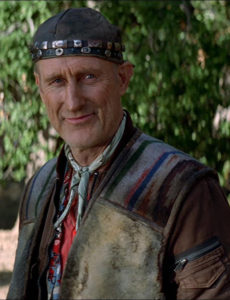
We quickly discover that Old Zefram Cochrane, who disappeared and was presumed dead in space at age 87, crash-landed on Shitty Planet and was rescued by the Glow Cloud, who restored him to a hale and hearty 35, supposedly because it (“she,” according to some deeply uncomfortable side-dialogue about the universality of the gender binary as a negligent excuse to give the Universal Translator a feminine voice, no I’m not still mad about that for like sixteen different reasons, why do you ask) loves him. Given that he set out into space with the intention of dying there, you’d think he’d be more pissed about the save, but… no.
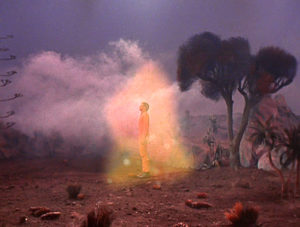
Candidly: the romantic love we’re told exists between Cochrane and the being he calls the Companion is pretty ham-handed and awkward and Heavy 1960s We-Have-No-Other-Vocab-For-This-Heteronormative, and we had a real problem with a lot of it. We also have a real problem with the way that poor, hyper-competent Assistant Commissioner Elinor Donahue, the episode’s putative female guest star, has barely any lines and virtually no agency, being present in the episode only to fall ill, hover on the ticking-clock brink of death, and then be forced into a body-sharing symbiosis with the Companion, which dooms whatever remains of Elinor to living out her life on Shitty Planet with a dude who swears he loves her/them/it even though he was having a xenophobic freakout over the idea roughly fifteen minutes ago but apparently has no problem with it now that she’s in the body of a conventionally-attractive human woman (who btw had literally no say in the matter).
This happens a lot in original Trek: mostly you can see the good intentions, but also a glaring lack of the the… vocabulary? discourse? sensitivity? to pull it off. Metamorphosis is another episode that, with a few tweaks here and there, could have been a genuinely interesting and touching treatise on the universality of love, but as it stood, mostly it just pissed us off.
The good news is – let’s end on a high note – is that this is, indeed, is a question that is explored repeatedly within the Trek Universe: What is love? Are some kinds of love more valid or precious than others? Just how different can two sentient beings be, before their differences make meaningful love impossible? For the most part, later Trek comes down with a firm and consistent answer that drives home one of the fundamental messages of Star Trek: that it is our similarities, and not our differences, that matter most.
Podcast: Play in new window | Download | Embed
Subscribe: Apple Podcasts | Email | RSS
Ari
June 22, 2016
A Brief Hiatus
As 2/3 of us are moving house in two days, there will be a brief hiatus while we get ourselves and our worldly possessions (including our recording equipment) from one place to the other. But have no fear, for we’ll be back in two weeks with discussion and review of the extraordinary crapshow that is Season 2, Episode 9: Metamorphosis.
In the meantime, please enjoy this pleasant and highly topical gif from Star Trek IV: The Voyage Home. The voyage to our new home will probably be much less enjoyable than the conclusion of this movie, but live in hope, right?

Ari
June 15, 2016
Episode 37 – TOS 2×08: “I, Mudd”
Since this is an episode where our fair ship stumbles, for the second time, across Harcourt Fenton Mudd, you might not expect a lot of substance. And sure enough, this is an episode where our crew finds (and by “finds” we of course mean “are hijacked there by a robot”) Harry Mudd set up on a planet of cheerfully servile robots… most of whom were constructed to his “personal specifications” and he is definitely sexing up on the regular.
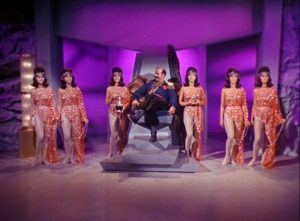
What you might not expect is that this is an episode written and aired during the golden age of artificial intelligence: a time when governments were pouring money into research, robots were in every sci-fi story that made it to the mainstream, and everyone in the know was sure we’d see the AI singularity by the 1980s.
That didn’t happen, of course (OR DID IT???), but the fact remains that this episode is chock-full of seriously fascinating nods to its era and the history of AI and robotics, both in sci-fi and in the real world. It’s a particular homage to all things Asimov, from the very title of the episode to Mudd’s many android co-stars’ faithful adherence to the Three Laws of Robotics, as well as the Zeroth Law.
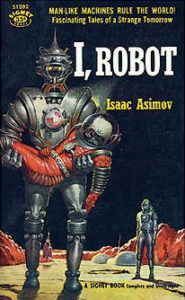
Not what you’d expect from an episode that might as well be subtitled Harry Mudd And The Planet of the Sexbots, but what the hell. Harry Mudd is still a contemptible trashbag of a human being, but if you’re at all interested in the way AI and robotics has been played out in popular culture, watch this one with an interested eye; I promise it’s worth it at least once.
Podcast: Play in new window | Download | Embed
Subscribe: Apple Podcasts | Email | RSS
Ari
June 8, 2016
Episode 36 – TOS 2×07: “Catspaw”
Just to give you an idea of our impressions for this week, most of our notes for this episode consist of repeated interrobangs and the word “WITCHES?!?!” underlined multiple times.
It’s best not to try and view this episode through much of a critical lens. There’s some vague Macbeth references. There’s a few places where mostly you want to hear the Nightmare Before Christmas intro song. There is a sexy cat lady who is also, at times, an actual cat (the first of at least two Sexy Cat guest stars in TOS, believe it or not). There is my only enduring childhood memory of this episode: the U.S.S. Enterprise encased in a block of clear plastic.
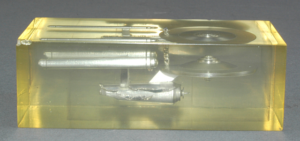
So that’s what’s there. So what’s not there? Is it a coherent explanation of who or what our villains are or what they’re after? DING DING DING CORRECT. We have no idea why two aliens who apparently invaded our dimension with (yet another) assistive machine that grants them nearly-invincible powers of illusion and impact do any of the things they do, least of all why they might kidnap a bunch of humans from a passing starship and imprison them in a castle straight out of some movie lot’s Scary Halloween Tour.
What we do know is that apparently their true forms look like this:
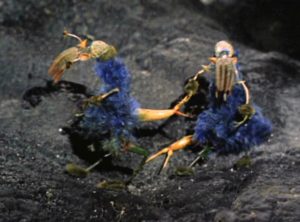
…yeah, we’re as confused as you are.
Podcast: Play in new window | Download | Embed
Subscribe: Apple Podcasts | Email | RSS
